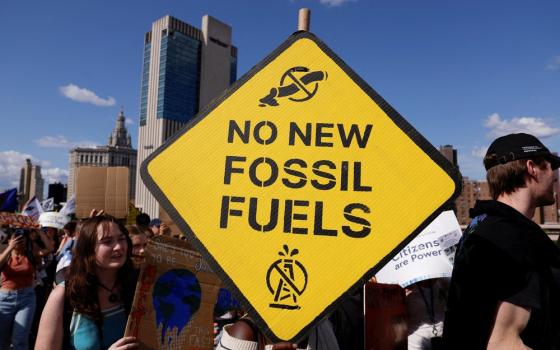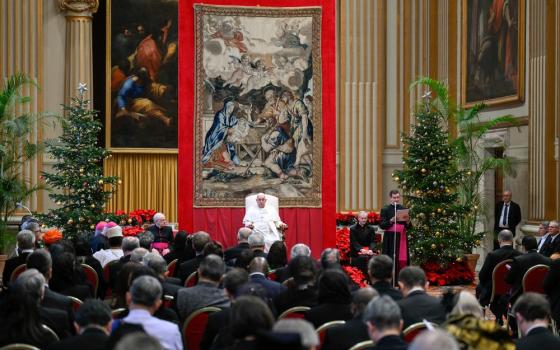It has taken me more time than I wished to respond to a query over at Commonweal from Father Joseph Komonchak about a post I wrote here at “Distinctly Catholic.” My original post, which can be found here, dealt with a recent speech by Archbishop Charles Chaput in which I faulted Chaput for gliding past some of the difficulties in his reading of the American founding.
One does not respond casually to a query from Fr. Komonchak who knows more about Vatican II than anyone I know. Additionally, I had to track down a specific book that I had lent someone because part of it was on point. But, in the event, the issue Fr. Komochak raised is perennial so the lack of timeliness does not diminish its import.
The question is twofold: Does the Second Vatican Council’s Decree on Religious Liberty endorse the notion of freedom at the heart of the First Amendment? and, secondly, does the fact that we even have to ask the question make Pope Benedict squirm?
John Courtney Murray, S.J., had long been trying to make the case that the Church should abandon its official teaching, namely, that the ideal relationship between Church and State was a union of the two wherever Catholics were in the majority and a demand for religious freedom wherever Catholics were a minority. This obvious double standard was defended on the grounds that “error has no rights.” Murray was silenced in the 1950s for advocating a different position that would recognize the validity of the American system of separation of Church and State. His role at Vatican II was indispensable.
At Vatican II, the number one issue for the Americans, who had just endured the slurs about dual loyalties during the Kennedy campaign, as well as many prelates who lived under communism, was the issue of religious liberty. The schema for a document on religious liberty had been assigned to one of the most friendly of Vatican prelates, Cardinal Augustine Bea, who headed the Secretariat for the Promotion of Christian Unity. But, the fact that the issue was grouped with ecumenical concerns raised as many concerns as it answered.
At a conference held at Notre Dame shortly after the Council closed, Murray said, “The result was a certain confusion between two distinct problems: the moral-ecumenical problem of relationships between Catholics and non-Catholics, and the juridical-political problem of religious freedom in its contemporary technical sense.” This, in fact, led to a deeper problem, namely, Murray rooted the right to religious freedom in the dignity of the human person. But, the dignity of the human person has other attributes and some Council fathers were worried that merely endorsing a particular juridical notion would suggest an acceptance of Enlightenment indifferentism. Consequently, four times in the text of Dignitatis Humanae, the Council fathers link religious freedom, via human dignity, with the moral imperative of searching for the truth. As Murray said at the Notre Dame conference: “One might question, for instance, the prominence given to man’s moral obligation to search for the truth, as somehow the ultimate foundation of the right to religious freedom….But behind this insistence on it, there lay a preoccupation that was rather more pastoral than theoretical. The concern was lest a divorce seem to be instituted between the juridical order of man’s relationship to other men and to political authority and the moral order of man’s relationship to the transcendent order of truth and to the authority of God. More briefly, the concern was lest religious freedom be misunderstood to mean a freedom from the claims of truth – in particular, as these claims are declared by the Church.”
Murray later said, “The real difficulty, however, is that the argument from man’s duty to search for the truth, whatever its value, does not deserve the fundamental place in the structure of a demonstration of the right to religious freedom. The reason is that it fails to yield the necessary and crucial political conclusion, namely, that government is not empowered, save in the exceptional case, to hinder men or religious communities from public witness, worship, practice, and observance in accordance with their own convictions.” Murray was, here, seeking to build a solid justification for the First Amendment. That was his goal. But, he could not escape the “somewhat troubled waters” that his stance invited laicism.
Later on, at that same Notre Dame conference, Murray was asked a question that concluded with these words: “What I am concerned with here is the negative cast of the conception of freedom in your relating it to the obligations of the state. I think you probably know what I’m driving at here.” Murray replied: “Yes, I was afraid somebody might head toward difficult and somewhat troubled waters, that the Declaration itself tried to skate around.” So, Murray was aware of the issues I am raising. And, as he says, the Declaration, while it certainly affirms the right of religious liberty explicitly, as Fr. Komonchak notes, it also does more than that. It places the idea in a context that is thoroughly alien to the context within which the American founders operated.
[I introduce a related issue, not essential to this argument, but essential to so many issues today. Murray went on to say, “You see – here is the difficulty, at least my difficulty. I don’t see how you promote an immunity – making somebody more and more immune.” Alas, as we figure out how to guarantee conscience protections for Catholic institutions with the new health insurance mandates, or as we seek to shore up parental rights in various ways, or we seek to avoid certain regulation of religious organizations, all these entail “promoting an immunity.”]
Sir Isaiah Berlin is the great scholar who first formulated this distinction between negative and positive conceptions of liberty in his 1958 inaugural Chichele lecture, “Two Concepts of Liberty.” Therein, Berlin said that negative liberty “is involved in the answer to the question, ‘What is the area within which the subject – a person or groups of persons – is or should be left to do or be what he is able to do or be, without interference by other persons?’” The second, positive idea of liberty, “is involved in the answer to the question, ‘What, or who, is the source of control or interference that can determine someone to do, or be, this rather than that?’” Berlin was concerned that whenever the state has some say in answering the second question, doom is certain. It is an undeniable fact of history that the absence of ontological and teleological concerns on the part of the state has usually been experienced as a political and civilizational blessing. As Aileen Kelly characterized Berlin’s “Two Concepts of Liberty,” Berlin “defended the notion of negative freedom against the encroachments of teleological doctrines linking liberty to overarching goals.”
But, the Church cannot, as the founding fathers did, plead agnosticism about teleology and ontology. The Church cannot fail to link freedom to “overarching goals.” Clearly, one of the themes of Pope Benedict's pontificate has been that freedom, when unmoored from the search for truth, leads to relativism. And, I recall distinctly the first time I realized that Vatican II has not neatly resolved these issues. It was during Pope John Paul II's inaugural sermon in 1978, when he delivered his famous line, "Do Not Be Afraid: Open Wide the Doors for Christ." The newly installed Holy Father listed areas of life that needed to be opened to Christ and in on that list he said, "Open wide the doors of state." I thought to myself, wait a minute. In the U.S. we don't open the doors of state to Christ, do we?
The Council fathers were concerned about laicism, a concern that obviously did not animate the founding fathers, steeped as they were in decidedly anti-Catholic ideas about religion and its relationship to the state. And, John Courtney Murray, great though he was, could not achieve for the Enlightenment what Aquinas achieved for Aristotle, a synthesis that resolved the difficult issues. No one has yet done so. I readily confess it will take a greater mind than mine to forge such a synthesis. But, I think sufficient time has passed that we must ask the question whether or not the failure to achieve a synthesis might be because no such synthesis can be achieved.
None of these issues were raised, still less answered, by Archbishop Chaput. He reads the founding fathers the way a fundamentalist reads Genesis, cherry picking a text he likes and ignoring the complexities of the issues involved. Nor can we pick out the parts of Vatican II’s Decree on Religious Liberty that we like and ignore the rest: The text is a whole, and what it affirms about religious liberty in the opening chapters, it encumbers in the latter chapters. I love the First Amendment as much as anybody, and certainly, as a Catholic in America, I am nervous in raising these profound issues. But, they must be faced. What St. Paul, and the Council, meant by the “freedom of the children of God” is not what Madison or Hamilton meant by freedom. They embraced Berlin’s idea of negative freedom. I do not see how a Catholic can be satisfied with it.



